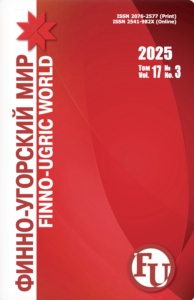DOI: 10.15507/2076-2577.012.2020.03.230-241
Complex nouns of common type in the Erzia and Hungarian languages
Tatiana P. Ariskina,
Candidate Sc. {Philology}, Associate Professor, Department of Finno-Ugric Philology,
National Research Mordovia State University
(Saransk, Russia), ariskina82@mail.ru
Introduction. Word building is used to form integral complex words on the basis of two or more simple ones. The initial base can be a group of equal lexical units or a phrase. There are many derivational types of composites, the study of which allows us to trace what trends are manifested in the modern word building system of the language. Topical comparative research in this area contributes to the replenishment of the theoretical base and makes a significant contribution to teaching methods. Within the framework of this article, the following tasks are solved: to establish derivational connections of complex words, to classify composites in the Erzia and Hungarian languages, to identify ways of word formation of complex nouns and the degree of their productivity, to carry out a comparative analysis of derivational formants in Erzia and Hungarian.
Materials and Methods. The material for the research was bilingual dictionaries: Erzia-Russian and Hungarian-Russian. The author used a descriptive method, methods of synchronous analysis, formal semantic and component analysis, historical-comparative and comparative-comparative methods, as well as quantitative analysis.
Results and Discussion. As a result of the analysis of a continuous sampling from the dictionaries, it was found that the share of compound nouns with a compositional connection in both languages is within 20% of the total number of compound nouns. This means that the creation of composites is less productive than the formation of words with a subordinate link. In most cases, the first component in the examples under consideration is a noun, the history of which can be easily traced, in particular by derivational suffixes. In rare cases, the components of a compound word have lost their meaning.
Conclusion. The intensity of the use of word building methods in the modern Erzia and Hungarian languages allow the production of words with a complex structure. The increase of the interest in comparative research indicate the need to study this phenomenon from a historical-comparative standpoint.
Key words: complex words; compound nouns; compositional connection; word-formation model; Erzia language; Hungarian language.
For citation: Ariskina TP. Complex nouns of common type in the Erzia and Hungarian languages. Finno-ugorskii mir = Finno-Ugric World. 2020; 12; 3: 230–241. (In Russian)






















